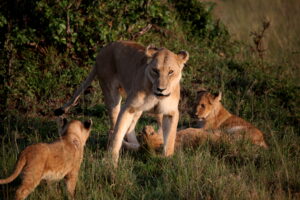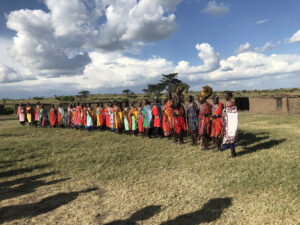Today is our full day in the Masai Mara and it does not disappoint. A day of dueling telephotos and herds of safari vans, but a day of what seems like phenomenal luck as we see an incredible show of this very exotic wildlife.
We find what must be the same pride and park right next to them. The females saunter past our vans and sit in the sun as the 6 cubs cavort in the bush. Eventually, they feel the need for motherly comfort but struggle to find a path between our vans to get there. What a show! We then find the 2 males
 lounging on a distant hill and after a time, they get up and walk casually past us. One walks to within 10 feet of the van and stares me down for a minute or so before walking on.
lounging on a distant hill and after a time, they get up and walk casually past us. One walks to within 10 feet of the van and stares me down for a minute or so before walking on.
Two of the cheetah strike a pose on a sloping tree trunk. A bit later we encounter all 3 again and they have a very fresh kill (zebra) that they share for lunch.
After our lunch, we decide to take in the “Masai Village” excursion. We are welcomed to a small compound (a circle huts within a thornbush fence with an open gathering area in the middle) and our host is a secondary school graduate in Masai garb whose English is quite good. After he makes sure that we all pay $20 to the chief’s son, he gives us a briefing, then takes us inside the compound for a hopping dance from the young men and then a welcome dance from some of the younger women, before our tour of one of the huts. It is mud (dung, actually) walls over a stick frame with a mud, plastic and thatch roof and inside, a main room with rock and mud stove + 4 tiny side rooms and a larger one for the young animals (keeps them from nursing so that the Masai can milk their goats and cows). The hut seems advanced compared to the very simple Luo and Kikuyu huts that I’ve seen (typically with a single mud partition and a primitive 3-stone fireplace).
and inside, a main room with rock and mud stove + 4 tiny side rooms and a larger one for the young animals (keeps them from nursing so that the Masai can milk their goats and cows). The hut seems advanced compared to the very simple Luo and Kikuyu huts that I’ve seen (typically with a single mud partition and a primitive 3-stone fireplace).
Then it’s time for the “gift store.” (Ever notice how you can’t exit the museum without going through the gift shop?) The masai funnel us into an adjoining circle of stalls where they display, family by family, crafts that they have made (which all look suspiciously alike). And the hard sell begins in earnest.
Could be that it’s just my problem, but this whole experience has been a bit uncomfortable for me. I feel a little exploited and exploitative — coming as very foreign tourists to peer at how they live, in what appears to be a compound a little forced into non-advancement (none of the tin roofs evident everywhere else), with them all on display, and forking over their equivalent of 4 days’ wages from each of us and then hit up with outrageous prices for goods that are not indigenous nor relevant for local markets (tourist only). On the other hand, it’s not like they can’t use the money (hopefully, the chief shares) and it is a powerful cultural experience for us. I think I just feel that we’ve put them in an unnatural situation because of the lure of tourist money and that becomes everyone’s focus. And I just can’t wait to get to Achungo.
Late that afternoon we venture out again in our vans for the sights.
“What is that large herd on that distant hill?”
“Just some stupid zebra.”
As we become a bit inured to the increasing commonality of the exotic, I become famous for my teasing reference to how we find zebra in every direction on every drive. But not just zebra–we have no problem finding elephants and gazelles and giraffes and an ostrich and warthogs and lions and cheetah…
